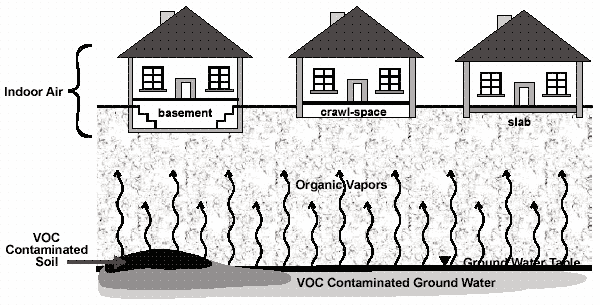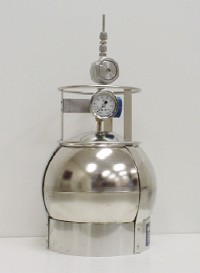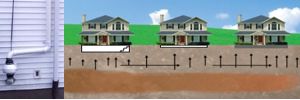|
Guidance Documents Vapor Intrusion Fact Sheet: Evaluating Indoor Air |
||||||||||||||||||||||||||||||||||||||||||||||
A variety of factors can influence whether vapor intrusion will occur at a building located near soil or ground water contaminated with VOCs. These include, but are not limited to, the concentration of the contaminants, the type of soil, the depth to ground water, the construction of the building, the condition of the foundation or slab and the existence of underground utilities that can create pathways for vapors to travel. Short term exposure to high levels of organic vapors can cause eye and respiratory irritation, headache and/or nausea. Breathing low levels of organic vapors over a long period of time may increase an individual’s risk for respiratory ailments, cancer and other health problems. Organic vapors can be present inside a building at potentially harmful levels without being detectable by odor. Sub-slab soil gas testing, near-slab soil gas testing and/or indoor air testing are usually required to determine whether vapor intrusion is occurring at a property. Testing for vapor intrusionIf your home or building is located near VOC-contaminated soil or ground water, NJDEP or an environmental contractor may ask permission to evaluate your property for vapor intrusion. This process typically involves first conducting sub-slab soil gas testing to check for vapors beneath the building, followed by indoor air testing, if necessary. During sub-slab testing, a small hole is bored through the basement floor or slab and a sample of the soil gas (the air trapped between the soil particles) is collected using an evacuated air testing canister (see below). If it is not possible to collect a soil gas sample from beneath the floor or slab, the sample may be collected by placing a probe in the soil directly adjacent to the building (near-slab testing). The soil gas sample is then sent to a certified laboratory to be analyzed for VOCs. If the analysis shows VOCs related to the subsurface contamination are present above NJDEP’s Soil Gas Screening Levels (SGSL), then indoor air testing is necessary.
During indoor air testing, a canister is placed in the basement, crawl space or other part of the building for a period of time (normally 24 hours). If the analysis of the indoor air sample shows VOCs related to the subsurface contamination are present above NJDEP’s Indoor Air Screening Levels (IASL), vapor intrusion is likely occurring. Additional evaluation of the property may be needed to confirm this finding. Background contaminationMany materials and substances commonly found in commercial and residential settings, such as paints, paint thinners, gasoline-powered machinery, certain building materials and cleaning products, dry cleaned clothing and cigarette smoke, contain VOCs that may be detected by indoor air testing. Even VOCs from motor vehicle emissions and other outdoor sources can contaminate indoor air. When VOCs from these sources are detected during indoor air testing, they are referred to as background contamination. Sometimes it can be difficult to determine whether the VOCs detected inside a building are due to vapor intrusion, background contamination or a combination of both. Before your building is evaluated for vapor intrusion you should receive a copy of NJDEP’s Instructions for Occupants – Indoor Air Sampling Events. Please follow these instructions to minimize background contamination and help ensure that the test results are as definitive as possible. Addressing vapor intrusionIf testing confirms vapor intrusion is causing potentially harmful levels of VOCs to accumulate inside a building, a subsurface depressurization system may be installed at the property. The system prevents vapors from entering the building by continuously venting the contaminated air beneath the basement slab or crawl space to the exterior of the structure. Subsurface depressurization systems are also used throughout the country to reduce levels of naturally occurring radon gas in buildings. See NJDEP’s fact sheet titled Subsurface Depressurization Systems for more information about how these systems work.
Alternate Format for This Document
Sections
Instructions for Occupants— Indoor Air Sampling Events, the Subsurface Depressuization Systems fact sheet and general information
about vapor intrusion
can be found in NJDEP’s Vapor
Intrusion Guidance Document,
which is available at https://www.nj.gov/dep/srp/
|
||||||||||||||||||||||||||||||||||||||||||||||
| To report an environmental
incident impacting NJ, call the Toll-Free 24-Hour Hotline |
||
Contact DEP | Privacy Notice | Legal Statement & Disclaimers | Accessibility Statement |
||
Site Remediation Program: SRP
Home | About SRP |
Search | Help Copyright © State of New Jersey, 1996- |


